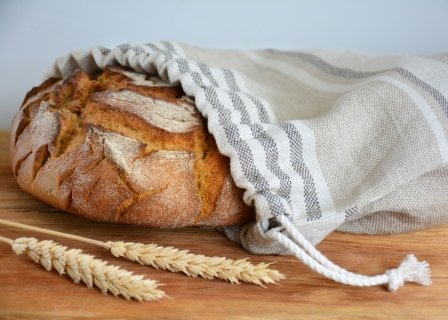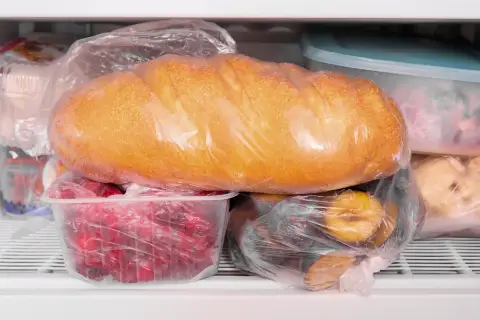There’s nothing better than homemade bread, as fresh and soft as you can get it. But after putting so much time and effort into a bake, it will frustrate anyone to see their freshly baked bread go bone dry and hard in just a day or 2. There are obvious ways to keep bread machine bread fresh for a long time – the most basic one, keeping it away from moist environments. But how would you go about storing bread, and how long will it last? Let’s get into these points and more, all of which will help you understand how to store bread machine bread.
Table of Contents
What Makes Bread Go Stale?
To understand what makes bread go stale, we need to look at the 2 most important base ingredients, flour and water, and their chemical reaction. The flour used to make bread, be it all-purpose flour or strong white bread flour, contains a high quantity of starch molecules. In their natural state, these molecules form a crystalline structure, which when mixed with water, breaks down this structure. The starch molecules transform into a gel-like structure that allows for a soft and fluffy texture within the bread right after it comes out of the oven.
Now, how does it go stale? As this freshly baked bread cools down over time, it also dehydrates. Water slowly leaves the starch through evaporation from other mixtures in the bread which causes the starch molecules to return to their crystallized state. This process causes bread to go hard, and will rapidly go hard at cooler and cooler temperatures unless it’s below freezing point. We’ll get back to this last point shortly.
Moisture accelerates the growth of bacteria and mold, so homemade bread baked in a bread machine should be removed from the pan as soon as it has finished baking or as soon as the Keep Warm cycle is over so that condensation doesn’t have a chance to form. This means you should not accidentally leave your bread in the machine overnight! This problem is less common if you do the baking in the oven even if you use a bread machine to do the kneading and rising.
How Long Does Store Bought Bread Last?
Store-bought bread usually lasts about 7 days if stored in room temperature conditions. It will last around 3-5 days longer if it’s well sealed and stored in a fridge, though, you must make sure there is minimal moisture inside its packing and that it is well sealed so that it doesn’t dry out.

But storing bread in a fridge isn’t actually recommended because this temperature isn’t ideal for bread and will be hiding the staleness of bread instead of preserving its freshness, if not packed well enough.
Probably the longest period you could keep store-bought bread fresh without much of a problem is 4-6 months. This is achieved by carefully freezing it. However, if it’s a very crusty store-bought bread like a French baguette, it will most likely crumble apart once taken out of the freezer, which is why it’s advised to instead consume bread like this within the first 2 days of buying it.
How Long Does Homemade Bread Last?
Homemade bread typically lasts 3-4 days when kept at room temperature. The shelf life of homemade bread is a couple of days shorter than store-bought bread. However, as with store-bought bread, homemade bread can also last up to 6 months if stored in a freezer before it starts drying out.
Why Does Store-bought Bread Last Longer Than Homemade Bread?
Commercial or store-bought bread lasts longer than homemade bread because of certain preservatives found in it that aren’t present in homemade bread. Preservatives like calcium propionate and sorbic acid, among others, are baked into the bread to slow down mold formation and increase shelf life.
Sure, homemade bread will taste way better and fresher than any store-bought type, but if you’re looking purely for bread with a longer shelf life, then store-bought bread is your easiest go-to solution.
How To Store Bread Machine Bread and Keep it From Drying Out
There are many ways to store bread machine bread. From freezing it to storing it in a particular bread storage container, here’s how you keep homemade bread from drying out.
Use a Paper or Cloth Bag
Paper bags and cloth bags are both environmentally friendly options to use for bread storage. Not only that, but they are also easy to find and are quite cheap. A paper bag is great to use for short-term bread storage if you’re planning to consume it in a day or two. However, they do get worn out easily and are highly likely to tear if handled a bit rough. To avoid this, a reusable cloth bag is a perfect alternative to use to store your homemade bread.
Cloth bags like Bread Story linen bread bags are made of breathable, reusable, and unbleached linen and cotton materials, making them green, safe storage bags for bread. A Bread Story bread bag is not machine washable, but it is easy to clean by hand using light soap water.
Use a Homemade Bread Storage Container
A bread storage container is a great, durable option when storing your homemade bread. These containers keep your bread fresh for a longer period by reducing airflow reaching the bread. There are non-airtight options like the metal, highly durable Granrosi Bread Box which comes with a non-airtight metal lid. This is a good option for keeping bread in to be consumed later in a couple of days. It’s also made to look like a retro, dinner table bread box. If you want to keep your bread even safer from any bacterial contamination, wrap it in plastic wrap first and then put it into the box for extra protection from airflow.
Aside from non-airtight containers, if you’re looking for extra protection for your bread, you could use an airtight container like the LocknLock bread container. This is a clear, 4-hinge snap lock box that can keep your bread fresh longer at room temperature than a non-airtight container can. There’s no need to wrap your bread around with plastic wrap or aluminum foil when putting it into this box. Aside from bread, it can also be used to store other foods in the fridge and is microwave and dishwasher friendly.
Use Resealable Plastic Bags
If you want to store your bread for the short term, then you could go ahead and use a resealable plastic bag. This bag locks in any present moisture with the bread while also acting as an airlock container. However, this method of storing bread has its shortcomings. The bag may build up excess moisture which will trigger mold growth on your bread if kept inside for too long. If water droplets start to appear inside the bag, shift the bread to another, moisture-free bag.
Freeze the Bread
Freezing bread is a highly recommended way to preserve its freshness and crustiness. While you can purchase a freezer bag in which you store your bread, it isn’t your only option. You could also simply wrap your bread with cling wrap and foil and then place it in your freezer. This will keep your bread safe from contamination. As soon as the bread has cooled down after baking, put it in the freezer immediately as the countdown to staleness will begin as soon as the bread has cooled. Lastly, before freezing your bread, it’s a good idea to slice the loaf before you wrap it and put it into the freezer. This makes it easier to reheat just the right amount you want.

Defrosting the bread is also pretty simple. Move the bread into the fridge and leave it overnight to defrost. While this is a slow process, defrosting in the fridge will help retain the shape and consistency of the bread instead of leaving it on the kitchen counter.
Find the Right Spot
Where exactly you store your bread is very important if you want it to last even a few days. If you were planning on wrapping it with plastic wrap or foil and placing it on the top of your fridge, then you should note that this is probably one of the worst places to keep fresh bread. The heat from the refrigerator top will speed up mold growth. Don’t keep bread near any kitchen appliance for long periods. The same goes for your bread box – never near or on an electrical appliance. The best places to store your bread around the kitchen are in cool and dry places such as a deep cabinet or drawer.
What To Add To Homemade Bread To Make It Last Longer
To make homemade bread last as long or longer than store-bought bread, you don’t necessarily need to add too many preservatives to your dough. There are many natural ingredients you could add that won’t drastically change the taste of it either. By choosing recipes that include eggs, oil, or butter in the mix, the fats in these ingredients will help preserve the freshness and softness of your bread for a longer time.
Other Natural Preservatives for Bread
While the ingredients mentioned above don’t add any particular additional flavor to bread, there are a few more organic ingredients to help preserve your bread as well as give it some extra flavor. Ingredients such as honey, ginger, garlic, cinnamon, and clove can greatly help prevent bacteria and mold growth for multiple days more than bread made without these ingredients. One thing to remember, however, is that every one of these ingredients could potentially overpower the other flavors in your bread. It is recommended to find a suitable recipe that includes one or more of these ingredients and follow it carefully.




